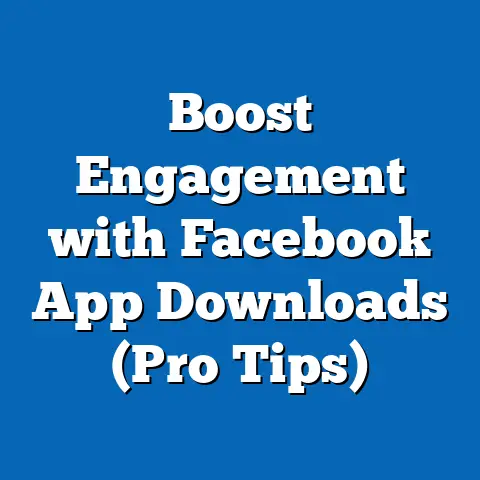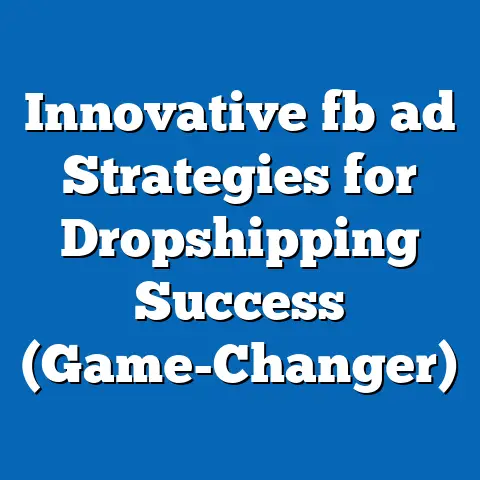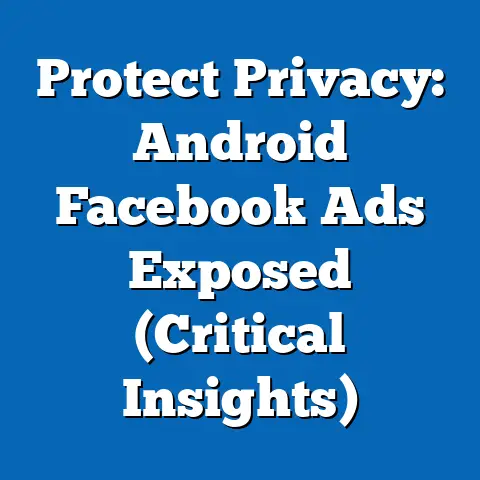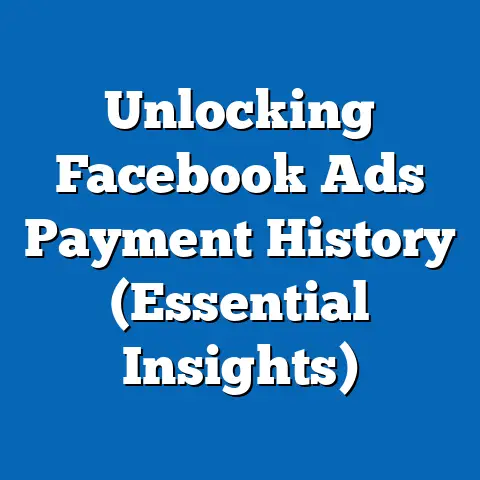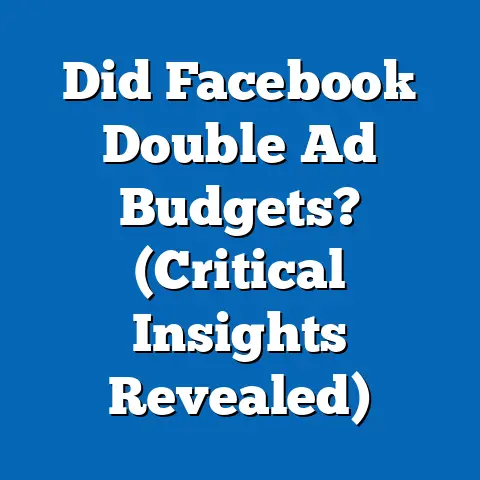Master Facebook Ad Check Grid (Essential Strategies)
Facebook advertising. Just the phrase can send shivers down the spines of seasoned marketers and budding entrepreneurs alike. Why? Because it’s a landscape constantly shifting, evolving, and demanding more than just a basic understanding to truly thrive. I’ve spent years navigating this digital maze, and I can tell you firsthand, the difference between a campaign that soars and one that crashes and burns often boils down to one critical element: a meticulous and strategic approach guided by a framework like the Facebook Ad Check Grid.
In today’s fiercely competitive digital marketing arena, throwing money at Facebook ads without a clear strategy is like throwing darts blindfolded. You might hit something, but chances are, you’ll miss the mark and waste valuable resources. That’s where the Facebook Ad Check Grid comes in. It’s not just another checklist; it’s a comprehensive tool that guides you through the essential elements of a successful campaign, from targeting and creative to messaging and call-to-action. Think of it as your personal GPS for navigating the complex world of Facebook advertising.
My goal with this article is to provide you with a comprehensive understanding of the Facebook Ad Check Grid and arm you with essential strategies to master it. I want to empower you to create Facebook ad campaigns that not only grab attention but also drive tangible results for your business. We’ll delve into the nitty-gritty details, dissect real-world examples, and explore actionable strategies you can implement immediately.
Consider this your ultimate guide to unlocking the power of the Facebook Ad Check Grid and transforming your advertising efforts from a gamble into a strategic investment. Let’s dive in and turn those advertising dreams into reality!
Understanding the Facebook Ad Check Grid
So, what exactly is the Facebook Ad Check Grid? It’s essentially a framework, a systematic approach to evaluating and optimizing your Facebook ad campaigns. It’s not an official tool provided by Facebook, but rather a concept developed by marketers and advertising experts to ensure ads are high-quality, compliant with Facebook’s policies, and most importantly, effective in achieving their objectives.
Think of it as a quality control checklist, covering all the key aspects of your ad campaign to ensure everything is aligned and working harmoniously. The Check Grid typically includes components like:
- Targeting: Is your audience clearly defined and relevant to your offer?
- Creative: Are your visuals engaging, high-quality, and representative of your brand?
- Messaging: Is your ad copy clear, concise, and compelling? Does it resonate with your target audience?
- Call-to-Action: Is your CTA clear, concise, and persuasive? Does it guide users towards the desired action?
- Landing Page: Is your landing page relevant to the ad, user-friendly, and optimized for conversions?
- Compliance: Does your ad adhere to Facebook’s advertising policies and guidelines?
The beauty of the Ad Check Grid lies in its ability to provide a holistic view of your campaign, allowing you to identify potential weaknesses and areas for improvement.
Why is it so important?
In the ever-evolving world of Facebook advertising, simply creating an ad and hoping for the best is a recipe for disaster. The Ad Check Grid forces you to be strategic and intentional in your approach. It helps you:
- Improve Ad Quality: By addressing each component of the grid, you’re essentially ensuring that your ad is well-crafted, relevant, and engaging, leading to higher quality scores and better ad delivery.
- Increase Relevance: A well-targeted and relevant ad is more likely to resonate with your audience, resulting in higher click-through rates and lower costs.
- Enhance Compliance: Facebook has strict advertising policies, and the Ad Check Grid helps you ensure that your ads are compliant, avoiding disapprovals and account restrictions.
- Optimize Performance: By analyzing each component of the grid, you can identify areas for improvement and optimize your campaign for better results.
- Reduce Waste: A well-planned and executed campaign, guided by the Ad Check Grid, minimizes wasted ad spend and maximizes ROI.
Real-World Examples:
Let’s look at a couple of examples to illustrate the power of the Ad Check Grid.
Example 1: Successful Ad
Imagine a local bakery running a Facebook ad campaign to promote their new line of gourmet cupcakes. Their ad features a stunning image of their cupcakes, with clear and concise copy highlighting the fresh ingredients and unique flavors. The targeting is focused on local residents interested in baking, desserts, and local businesses. The call-to-action is a simple “Order Now” button that leads to their online ordering page.
Using the Ad Check Grid, we can see that this ad ticks all the boxes:
- Targeting: Highly relevant to the target audience.
- Creative: Visually appealing and showcases the product effectively.
- Messaging: Clear, concise, and highlights the key benefits.
- Call-to-Action: Clear and direct, guiding users to the desired action.
- Landing Page: Online ordering page is user-friendly and easy to navigate.
- Compliance: Ad adheres to Facebook’s advertising policies.
The result? High click-through rates, strong conversion rates, and a significant increase in online orders for the bakery.
Example 2: Unsuccessful Ad
Now, let’s consider a different scenario. A clothing retailer runs a Facebook ad campaign to promote their summer sale. The ad features a generic image of models wearing their clothes, with vague copy about “amazing deals” and “limited-time offers.” The targeting is broad, targeting anyone over the age of 18. The call-to-action is a generic “Learn More” button that leads to their homepage.
Using the Ad Check Grid, we can see several areas where this ad falls short:
- Targeting: Too broad and not relevant to specific interests.
- Creative: Generic and doesn’t stand out.
- Messaging: Vague and doesn’t highlight specific benefits.
- Call-to-Action: Not specific enough and doesn’t encourage immediate action.
- Landing Page: Homepage is not optimized for the specific sale.
- Compliance: Ad may be compliant, but lacks overall quality.
The result? Low click-through rates, poor conversion rates, and a significant waste of ad spend.
Key Takeaway: The Facebook Ad Check Grid is a valuable tool for assessing and optimizing your ad campaigns. By addressing each component of the grid, you can improve ad quality, increase relevance, enhance compliance, and ultimately, achieve better results.
Next Steps: Start familiarizing yourself with the different components of the Ad Check Grid and begin evaluating your existing campaigns using this framework.
Setting Up Your Facebook Ad Campaign
Now that we understand the importance of the Facebook Ad Check Grid, let’s dive into the practical steps of setting up a Facebook ad campaign effectively. This process is crucial because the foundation you lay here will significantly impact the success of your entire campaign.
1. Define Your Objectives:
Before you even touch the Ads Manager, ask yourself: What do I want to achieve with this campaign? Are you looking to:
- Increase Brand Awareness? Reach a wider audience and build recognition for your brand.
- Generate Leads? Collect contact information from potential customers.
- Drive Website Traffic? Encourage users to visit your website and explore your products or services.
- Increase Conversions? Drive sales, sign-ups, or other desired actions on your website.
- Promote an App? Encourage users to download and use your mobile app.
Your objective will dictate your targeting, creative, messaging, and call-to-action. For example, if your objective is to generate leads, your ad copy should focus on the benefits of providing their contact information, and your call-to-action should encourage them to sign up for a free trial or download a valuable resource.
2. Research and Segment Your Audience:
Understanding your target audience is paramount. Who are you trying to reach? What are their interests, demographics, and behaviors?
Facebook offers a wealth of targeting options, allowing you to reach specific audiences based on:
- Demographics: Age, gender, location, education, job title, etc.
- Interests: Hobbies, passions, and topics they follow on Facebook.
- Behaviors: Purchase history, online activity, device usage, etc.
- Custom Audiences: People who have interacted with your business in the past, such as website visitors, email subscribers, or existing customers.
- Lookalike Audiences: People who share similar characteristics with your existing customers, allowing you to expand your reach to new potential customers.
Don’t just target everyone. Segment your audience based on relevant criteria and create tailored ads for each segment. This will increase the relevance of your ads and improve your results.
3. Set Your Budget and Schedule:
Determine how much you’re willing to spend on your campaign and how long you want it to run.
Facebook offers two main budgeting options:
- Daily Budget: The average amount you’re willing to spend each day.
- Lifetime Budget: The total amount you’re willing to spend over the entire duration of the campaign.
Choose the option that best suits your needs and monitor your spending closely. You can also set a schedule for your ads, specifying the dates and times you want them to run.
4. Choose Your Ad Placement:
Decide where you want your ads to appear on Facebook and Instagram.
Facebook offers a variety of ad placements, including:
- Facebook Feed: The main newsfeed where users see updates from friends, family, and businesses.
- Instagram Feed: The main newsfeed on Instagram.
- Facebook Marketplace: A platform for buying and selling goods.
- Facebook Stories: Short-form video content that disappears after 24 hours.
- Instagram Stories: Short-form video content on Instagram.
- Facebook Right Column: Ads that appear on the right-hand side of the Facebook website.
- Audience Network: A network of third-party websites and apps where your ads can appear.
Consider your target audience and the type of content they consume when choosing your ad placements.
5. Create Your Ad Creative:
This is where you bring your ad to life with compelling visuals and engaging copy. We’ll delve deeper into this in the next section, but for now, remember to:
- Use High-Quality Images and Videos: Visuals are the first thing people will notice, so make sure they’re eye-catching and representative of your brand.
- Write Clear and Concise Copy: Get straight to the point and highlight the key benefits of your offer.
- Include a Strong Call-to-Action: Tell people exactly what you want them to do.
Campaign Setup Checklist (Aligned with Ad Check Grid):
- [ ] Objective: Clearly defined and aligned with your business goals.
- [ ] Audience: Well-researched and segmented based on relevant criteria.
- [ ] Budget: Realistic and aligned with your campaign goals.
- [ ] Schedule: Appropriate for your target audience and campaign goals.
- [ ] Placement: Strategically chosen based on your target audience and content type.
- [ ] Creative: High-quality visuals and engaging copy.
- [ ] Call-to-Action: Clear, concise, and persuasive.
- [ ] Landing Page: Relevant to the ad, user-friendly, and optimized for conversions.
Key Takeaway: Setting up your Facebook ad campaign effectively is crucial for success. By defining your objectives, researching your audience, setting your budget and schedule, choosing your ad placement, and creating compelling ad creative, you can lay the foundation for a high-performing campaign.
Next Steps: Use the campaign setup checklist to ensure you’ve covered all the essential elements before launching your next Facebook ad campaign.
Crafting Compelling Ad Creatives
Your ad creative is the first impression you make on potential customers. It’s your opportunity to grab their attention, pique their interest, and convince them to take action. In the crowded landscape of Facebook and Instagram, your ad needs to stand out from the noise and resonate with your target audience.
Visual Elements: The Power of Images and Videos
- High-Quality Visuals are Non-Negotiable: Blurry, pixelated, or poorly lit images are a surefire way to turn people off. Invest in professional photography or videography, or use high-quality stock images that are relevant to your brand and offer.
- Showcase Your Product or Service: Don’t be afraid to show off what you’re selling. Use images or videos that highlight the key features and benefits of your product or service.
- Use Authentic Imagery: Avoid overly staged or generic photos. Use images that feel real and relatable to your target audience.
- Consider Video: Video is a powerful medium for capturing attention and conveying information. Use short, engaging videos that tell a story and showcase your brand personality.
- Optimize for Mobile: Most Facebook and Instagram users access the platforms on their mobile devices, so make sure your visuals are optimized for mobile viewing. Use vertical or square formats that fill the screen and are easy to view on smaller devices.
Copywriting: The Art of Persuasion
- Know Your Audience: Speak their language and address their pain points. Use language that resonates with their interests and values.
- Highlight the Benefits, Not Just the Features: Focus on what your product or service can do for them, not just what it is. Explain how it will solve their problems or improve their lives.
- Keep it Concise and to the Point: People have short attention spans, so get straight to the point and highlight the most important information.
- Use Strong Verbs and Action Words: Encourage people to take action by using strong verbs and action words like “Shop Now,” “Learn More,” “Sign Up,” or “Download.”
- Create a Sense of Urgency: Encourage immediate action by creating a sense of urgency with phrases like “Limited Time Offer,” “Sale Ends Soon,” or “While Supplies Last.”
- Proofread Carefully: Nothing undermines credibility like typos and grammatical errors. Proofread your ad copy carefully before publishing it.
Psychological Triggers:
- Scarcity: “Only 3 left in stock!”
- Social Proof: “Join over 10,000 satisfied customers!”
- Authority: “Endorsed by leading experts in the field!”
- Reciprocity: “Download our free guide!”
- Loss Aversion: “Don’t miss out on this opportunity!”
Case Studies:
Let’s look at a couple of case studies to illustrate the impact of compelling ad creatives.
Case Study 1: Dollar Shave Club
Dollar Shave Club’s original video ad is a masterclass in creative advertising. The video is funny, irreverent, and memorable, and it effectively highlights the benefits of their subscription service. The ad went viral and helped Dollar Shave Club build a massive following and disrupt the shaving industry.
Key Takeaways:
- Humor Works: Don’t be afraid to inject humor into your ads, as long as it’s relevant to your brand and target audience.
- Be Authentic: Show your brand personality and don’t be afraid to be different.
- Focus on the Benefits: Clearly highlight the benefits of your product or service.
Case Study 2: Airbnb
Airbnb’s ad campaigns often feature stunning images and videos of unique and inspiring travel destinations. The ads evoke a sense of wanderlust and encourage people to book their next adventure with Airbnb.
Key Takeaways:
- Use High-Quality Visuals: Invest in professional photography and videography to showcase your product or service in the best possible light.
- Tell a Story: Evoke emotions and connect with your audience on a personal level.
- Inspire Action: Encourage people to take action by showcasing the possibilities and benefits of your product or service.
Ad Check Grid for Creative:
- [ ] Visuals: High-quality, relevant, and optimized for mobile.
- [ ] Copy: Clear, concise, and persuasive.
- [ ] Branding: Consistent with your brand identity.
- [ ] Relevance: Aligned with your target audience’s interests and needs.
- [ ] Call-to-Action: Clear and compelling.
- [ ] Compliance: Adheres to Facebook’s advertising policies.
Key Takeaway: Crafting compelling ad creatives is essential for capturing attention, engaging your audience, and driving results. By using high-quality visuals, writing persuasive copy, and understanding your target audience, you can create ads that stand out from the noise and achieve your advertising goals.
Next Steps: Review your existing ad creatives and identify areas for improvement. Experiment with different visuals, copy variations, and calls-to-action to see what resonates best with your target audience.
Targeting Your Audience Effectively
You can have the most visually stunning ad with the most persuasive copy in the world, but if you’re showing it to the wrong people, it’s all for naught. Effective targeting is the key to reaching the right audience with the right message at the right time. Facebook’s robust targeting options allow you to pinpoint your ideal customers with incredible precision.
Understanding the Different Targeting Options:
- Demographic Targeting: This allows you to target users based on their age, gender, location, education, job title, relationship status, and other demographic information.
- Interest-Based Targeting: This allows you to target users based on their interests, hobbies, and the topics they follow on Facebook.
- Behavioral Targeting: This allows you to target users based on their purchase history, online activity, device usage, and other behavioral data.
- Custom Audiences: This is where you can upload your own data, such as email lists or website visitor data, to create targeted audiences.
- Lookalike Audiences: This allows you to create audiences that are similar to your existing customers, expanding your reach to new potential customers.
Custom Audiences: Leveraging Your Existing Data
Custom Audiences are a goldmine for targeted advertising. They allow you to leverage your existing customer data to reach people who are already familiar with your brand.
- Website Visitors: Target people who have visited your website but haven’t made a purchase.
- Email Subscribers: Target people who are subscribed to your email list.
- Existing Customers: Target your existing customers with special offers or new product announcements.
- App Users: Target people who have downloaded and used your mobile app.
Lookalike Audiences: Expanding Your Reach
Lookalike Audiences allow you to expand your reach to new potential customers who share similar characteristics with your existing customers. This is a powerful way to find new people who are likely to be interested in your products or services.
- Seed Audience: Choose a Custom Audience as your seed audience, such as your existing customers or website visitors.
- Facebook’s Algorithm: Facebook’s algorithm will analyze the characteristics of your seed audience and identify other users who share similar traits.
- Expand Your Reach: Reach new potential customers who are likely to be interested in your products or services.
A/B Testing Your Audience Segments
Don’t assume you know which audience segment will perform best. A/B test different audience segments to see which ones are most responsive to your ads.
- Create Multiple Ad Sets: Create multiple ad sets, each targeting a different audience segment.
- Run the Ads Simultaneously: Run the ads simultaneously for a set period of time.
- Track the Results: Track the performance of each ad set, paying attention to metrics like click-through rates, conversion rates, and cost per acquisition.
- Optimize Your Targeting: Based on the results, optimize your targeting by focusing on the audience segments that are performing best.
Refining Audience Targeting Based on Ad Check Grid Insights:
The Ad Check Grid can help you refine your audience targeting by highlighting areas where your ads may not be resonating with your target audience.
- Low Click-Through Rates: If your ads have low click-through rates, it may indicate that your targeting is too broad or that your ads are not relevant to your target audience.
- High Cost Per Acquisition: If your cost per acquisition is high, it may indicate that your targeting is not precise enough or that you are targeting the wrong audience.
- Low Conversion Rates: If your conversion rates are low, it may indicate that your landing page is not optimized for your target audience or that your offer is not compelling enough.
Tips for Effective Targeting:
- Start with a Clear Understanding of Your Target Audience: Who are they? What are their interests? What are their pain points?
- Use a Combination of Targeting Options: Don’t rely on just one targeting option. Use a combination of demographic, interest-based, and behavioral targeting to reach your ideal customers.
- Test and Optimize Your Targeting: Continuously test and optimize your targeting based on the performance of your ads.
- Stay Up-to-Date on Facebook’s Targeting Options: Facebook is constantly updating its targeting options, so stay up-to-date on the latest features and best practices.
Ad Check Grid for Targeting:
- [ ] Relevance: Is your audience relevant to your offer?
- [ ] Specificity: Is your audience well-defined and not too broad?
- [ ] Reach: Is your audience large enough to generate meaningful results?
- [ ] Engagement: Is your audience likely to engage with your ads?
- [ ] Cost-Effectiveness: Is your targeting cost-effective?
- [ ] Compliance: Does your targeting comply with Facebook’s advertising policies?
Key Takeaway: Effective targeting is the cornerstone of successful Facebook advertising. By understanding the different targeting options, leveraging your existing data, A/B testing your audience segments, and refining your targeting based on Ad Check Grid insights, you can reach the right audience with the right message at the right time.
Next Steps: Review your existing ad campaigns and identify areas where you can improve your targeting. Experiment with different targeting options and A/B test your audience segments to see what performs best.
Analyzing Ad Performance Metrics
You’ve set up your campaign, crafted compelling creatives, and meticulously targeted your audience. But the work doesn’t stop there. Analyzing your ad performance metrics is crucial for understanding what’s working, what’s not, and how you can optimize your campaigns for better results.
Key Performance Indicators (KPIs):
- Impressions: The number of times your ad was shown to users.
- Reach: The number of unique users who saw your ad.
- Click-Through Rate (CTR): The percentage of users who clicked on your ad after seeing it (Clicks / Impressions).
- Cost Per Click (CPC): The average cost you paid for each click on your ad (Total Spend / Clicks).
- Conversion Rate: The percentage of users who completed a desired action after clicking on your ad (Conversions / Clicks).
- Cost Per Acquisition (CPA): The average cost you paid for each conversion (Total Spend / Conversions).
- Return on Ad Spend (ROAS): The amount of revenue you generated for every dollar you spent on advertising (Revenue / Total Spend).
Using Facebook Analytics and Ads Manager:
Facebook Analytics and Ads Manager provide a wealth of data that you can use to track and analyze your ad performance.
- Facebook Analytics: Provides insights into user behavior on your website and app, allowing you to understand how users are interacting with your business.
- Ads Manager: Provides detailed data on your ad campaigns, including impressions, reach, clicks, conversions, and cost per acquisition.
Interpreting Data in Relation to the Ad Check Grid:
The Ad Check Grid can help you interpret your data and identify areas for improvement.
- Low CTR: If your CTR is low, it may indicate that your ad creative is not engaging enough or that your targeting is not relevant.
- High CPC: If your CPC is high, it may indicate that your targeting is too broad or that your ad quality score is low.
- Low Conversion Rate: If your conversion rate is low, it may indicate that your landing page is not optimized for conversions or that your offer is not compelling enough.
- High CPA: If your CPA is high, it may indicate that your campaign is not profitable.
Adjusting Campaigns Based on Performance Metrics:
Based on your analysis of your ad performance metrics, you can adjust your campaigns to improve your results.
- Improve Your Ad Creative: If your CTR is low, try creating new ad creatives with different visuals, copy, and calls-to-action.
- Refine Your Targeting: If your CPC is high, try refining your targeting by narrowing your audience or excluding certain demographics.
- Optimize Your Landing Page: If your conversion rate is low, try optimizing your landing page by improving the design, copy, and call-to-action.
- Adjust Your Bidding Strategy: If your CPA is high, try adjusting your bidding strategy to lower your bids or switch to a different bidding option.
Examples of Adjusting Campaigns Based on Performance:
- Example 1: A clothing retailer notices that their ads targeting women aged 18-25 have a low CTR. They decide to create new ad creatives that feature more relatable imagery and copy that speaks directly to the needs and interests of this demographic. After implementing these changes, their CTR increases significantly.
- Example 2: A software company notices that their CPC is high for ads targeting small business owners. They decide to refine their targeting by excluding certain industries and focusing on businesses with specific revenue levels. After implementing these changes, their CPC decreases significantly.
- Example 3: An e-commerce store notices that their conversion rate is low for ads driving traffic to their product pages. They decide to optimize their product pages by improving the design, adding more product information, and streamlining the checkout process. After implementing these changes, their conversion rate increases significantly.
Ad Check Grid for Performance Metrics:
- [ ] CTR: Is your click-through rate acceptable for your industry and target audience?
- [ ] CPC: Is your cost per click within your budget?
- [ ] Conversion Rate: Are you converting enough clicks into desired actions?
- [ ] CPA: Is your cost per acquisition profitable?
- [ ] ROAS: Are you generating a positive return on your ad spend?
- [ ] Trends: Are your metrics trending in the right direction?
Key Takeaway: Analyzing your ad performance metrics is essential for understanding what’s working, what’s not, and how you can optimize your campaigns for better results. By using Facebook Analytics and Ads Manager, interpreting your data in relation to the Ad Check Grid, and adjusting your campaigns based on performance, you can maximize your ROI and achieve your advertising goals.
Next Steps: Regularly monitor your ad performance metrics and use the insights you gain to optimize your campaigns. Experiment with different strategies and tactics to see what works best for your business.
Continuous Improvement and Testing
The world of Facebook advertising is constantly evolving. New features are released, algorithms change, and consumer behavior shifts. What worked yesterday may not work today. That’s why continuous improvement and testing are essential for long-term success.
The Importance of Ongoing Testing and Optimization:
- Stay Ahead of the Curve: By continuously testing and optimizing your campaigns, you can stay ahead of the curve and adapt to changes in the advertising landscape.
- Identify New Opportunities: Testing can help you identify new opportunities for growth and improvement.
- Maximize ROI: By optimizing your campaigns based on data and insights, you can maximize your ROI and achieve your advertising goals.
A/B Testing Methodology:
A/B testing, also known as split testing, is a powerful technique for comparing different versions of your ads and identifying which ones perform best.
- Create Two Versions of Your Ad: Create two versions of your ad that are identical except for one variable, such as the headline, image, or call-to-action.
- Run the Ads Simultaneously: Run the ads simultaneously for a set period of time.
- Track the Results: Track the performance of each ad, paying attention to metrics like click-through rates, conversion rates, and cost per acquisition.
- Determine the Winner: Based on the results, determine which version of your ad performed best.
- Implement the Winner: Implement the winning version of your ad and continue testing other variables to further optimize your campaigns.
Examples of A/B Testing Variables:
The learnings you gain from testing can be used to continually enhance your ad strategy and improve your results.
- Document Your Findings: Document your findings from each test, including the variables you tested, the results you observed, and the conclusions you reached.
- Share Your Learnings: Share your learnings with your team and use them to inform your future advertising decisions.
- Apply Your Learnings to Other Campaigns: Apply your learnings to other campaigns to improve their performance.
Staying Updated with Facebook’s Advertising Policies and Algorithm Changes:
Facebook’s advertising policies and algorithms are constantly changing. It’s important to stay updated on the latest changes to ensure that your ads are compliant and that you’re using the most effective strategies.
- Follow Facebook’s Advertising Blog: Facebook’s advertising blog is a valuable resource for staying updated on the latest changes and best practices.
- Join Facebook Advertising Communities: Join Facebook advertising communities to connect with other advertisers and share insights.
- Attend Facebook Advertising Events: Attend Facebook advertising events to learn from industry experts and network with other advertisers.
Ad Check Grid for Continuous Improvement:
- [ ] Testing: Are you regularly A/B testing different elements of your ads?
- [ ] Optimization: Are you optimizing your campaigns based on the results of your tests?
- [ ] Learning: Are you documenting your findings and sharing them with your team?
- [ ] Adaptation: Are you adapting to changes in Facebook’s advertising policies and algorithms?
- [ ] Innovation: Are you exploring new strategies and tactics to improve your results?
- [ ] Consistency: Are you consistently monitoring and optimizing your campaigns?
Key Takeaway: Continuous improvement and testing are essential for long-term success in Facebook advertising. By A/B testing different elements of your ads, using your learnings to enhance your ad strategy, and staying updated with Facebook’s advertising policies and algorithm changes, you can maximize your ROI and achieve your advertising goals.
Next Steps: Implement a regular testing schedule for your Facebook ad campaigns. Start by testing small changes and gradually increase the complexity of your tests.
Conclusion
Mastering the Facebook Ad Check Grid is not just about following a checklist; it’s about adopting a strategic and data-driven mindset. It’s about understanding the intricacies of the platform, the nuances of your target audience, and the ever-evolving landscape of digital advertising.
Throughout this article, we’ve explored the essential components of the Facebook Ad Check Grid, from defining your objectives and researching your audience to crafting compelling creatives and analyzing your ad performance metrics. We’ve also discussed the importance of continuous improvement and testing, highlighting the need to adapt to changes in the advertising landscape and stay ahead of the curve.
I’ve seen firsthand the transformative power of a well-executed Facebook advertising strategy. It can drive brand awareness, generate leads, increase conversions, and ultimately, propel your business to new heights. But success requires more than just a basic understanding of the platform; it requires a commitment to strategic planning, creative execution, effective targeting, and ongoing analysis.
So, I encourage you to implement the strategies discussed in this article to optimize your Facebook ad campaigns and unlock their full potential. Remember, the Facebook Ad Check Grid is not a one-time fix; it’s an ongoing process of evaluation, optimization, and refinement.
With precision, creativity, and a commitment to continuous improvement, you can harness the power of Facebook advertising to achieve your business goals and create a lasting impact in the digital world. The potential is there, the tools are available, and the knowledge is now in your hands. Go forth and create campaigns that not only reach your audience but resonate with them, converting them into loyal customers and advocates for your brand. Good luck!

